
This site celebrates the life and work of sculptor
John Cassidy (1860 - 1939).
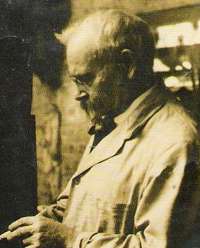
The last picture we have of John Cassidy (above) is from a view of him working on the plaque commemorating the retirement of J. L. Paton, High Master of Manchester Grammar School, in 1924.
John Cassidy had "Labour of Love"
From The Manchester Evening News, Thursday July 20, 1939. By a Special Correspondent:
While sisters of St Joseph stood beside his bed, bending low to catch the hardly audible words his lips were forming, they knew that John Cassidy, 79-year-old Manchester Sculptor, was dying and would never be able to finish his last work of art - a bust of the Pope.
He made a sign that he wanted some paper on which he scrawled the words: "my speech is leaving me. My one regret is that I cannot finish the bust now." That was shortly after midnight, and a few minutes later he was dead.
Miss C. Hughes, the matron of St Joseph's Hospital, Whalley Range, Manchester, took me along corridors between wards and private rooms, and up long flights of stairs, to a roof garden covered in with glass and bright with growing summer flowers.
"This is where John Cassidy did his last day's work as a sculptor," she told me, "and there is his unfinished bust of Pope Pius XII."
We walked across to a pedestal on which was a roughly modelled head in clay, the features of which were just forming into the likeness of the Holy Father. Round its base were the sculptor's tools as he left them a week ago.
Embedded in the shoulder was a piece of pasteboard, on which was glued a coloured plate of the Pope torn from a Catholic magazine. That was John Cassidy's only model for his last sculpture.
"It was a labour of love," said the matron. "He was fashioning it as a personal gift for the Rev. Mother Superior of the St Joseph's Convent. A site for it has not been decided upon yet, but it will be placed there and kept as a treasure without price.
"John Cassidy was a charming man and a very remarkable man. He talked like a man 30 years younger than he was. He just forgot age.
"When he knew he was not long for this world he called for his tools. So three weeks ago all his materials were sent down from his lodgings in Fallowfield, and he used to come up here every day to work on his bust of the Pope.
"Sometimes we would find him up and dressed at 5 o'clock in the morning ready to go to his studio on the roof. He would not give in to his infirmity.
"Last Thursday he came up very early in the morning and worked at the bust for hours. His hands were trembling, but he stuck at it until he collapsed and had to be carried back to bed."
Back in bed again, seriously ill, John Cassidy could not keep his mind off his last work. "If only I had a different clay," he whispered to the sisters, "I could have finished my bust in another hour. Only one hour off completion, and I don't like my hands to be idle."
John Cassidy's love for his art was the greatest thing in his life. He was a bachelor, was born in Ireland, and came to Manchester, a young man with a passion to fashion figures out of stone and clay and bronze.
When he was 22 he was sudying at the Manchester School of Art, specialising in modelling. He always worked in a black velvet cap which he wore at a rakish Bohemian angle, and soon he was doing work for famous British galleries and the Paris salons. He executed more than 200 busts, created war memorials from many towns and villages, and provided the city of his adoption with a number of fine works.
John Cassidy's statue of King Edward VII in Whitworth Park is one of his best-known works. There are others at Bristol, Belfast, Bolton, and Aberdeen. He has busts or statues at the Rylands Library, Queen's Park and the City Art Gallery.
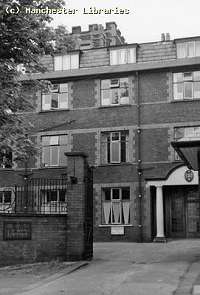
St Joseph's Hospital in 1961 (Manchester City Libraries)
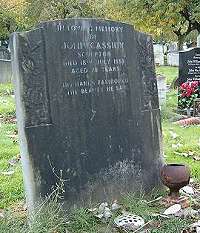
The gravestone in 2009 before refurbishment.
Acknowledgements
Special thanks are due to the following:
Doug Cassidy
John Lynch
The Slane Historical Society
James Hilton Monumental Masons
Manchester City Council online burial records
The staff of Manchester Local Studies Library.
John Cassidy's Last Days, July 1939
This page commemorates the 70th Anniversary of John Cassidy's death on 19 July 1939.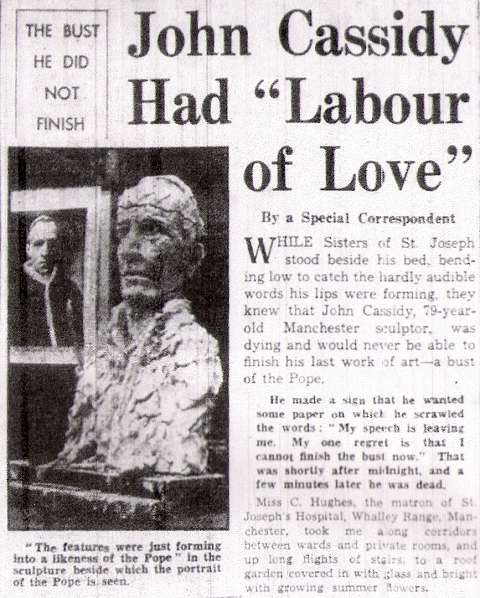
The story of John Cassidy's last days in the popular newspaper The Manchester Evening News (transcribed in full, left) gives us a glimpse of his human side, by contrast to the more academic version in The Manchester Guardian which is quoted by the few existing accounts of his life and work. It would be fascinating to know the identity of the 'Special Correspondent.'
'Something of a Legend'
Elsewhere in the press, The Manchester City News of 22 July 1939 has an editorial about three cyclists killed in collision with buses that week (two boys and a bridegroom-to-be), news of a film starring Gordon Harker as Inspector Hornleigh, famous radio sleuth, with Alastair Sim as Sergeant Bingham, at the Gaumont cinema. The threat of air raids is considered, as World War II loomed, as is the bomb threat from the Irish Republican Army. The main obituary of the week is for Sir Percy Scott Worthington, (31 January 1864 – 15 July 1939) Manchester-born architect, who was known for his work on Manchester Cathedral; he was the son of architect Thomas Worthington.
There is also an item about Cassidy, which also adds some personal details, especially about the last years of his life. We are told that he acted as an adjudicator of student's work at the College of Art, and that:
Mr Cassidy had become
something of a legend, and all over Britain old pupils and
colleagues spoke of him, his work, his mannerisms and his
Irish witticisms as they might speak of an Old Master.
Mr J Ashton Floyd, who also helped in this work and at one time assisted in Mr Cassidy's studio, said that he was looked up to by the younger generation of sculptors, and that he could never do too much to help them.
Mr Cassidy had a difficult struggle towards the end, especially after he lost his Plymouth Grove Studios to works extensions and seemed with it to lose a good deal of heart. He had a stroke two months ago and since then had been in hospital.
Mr J Ashton Floyd, who also helped in this work and at one time assisted in Mr Cassidy's studio, said that he was looked up to by the younger generation of sculptors, and that he could never do too much to help them.
Mr Cassidy had a difficult struggle towards the end, especially after he lost his Plymouth Grove Studios to works extensions and seemed with it to lose a good deal of heart. He had a stroke two months ago and since then had been in hospital.
The reference to J Ashton Floyd is interesting; as well as assisting in the Lincoln Grove studio, he had a career of his own, creating works such as the Ashton-under-Lyne war memorial of 1922 which features a variation on the 'soldier and angel' theme. He also created the Manchester Post Office Peace Memorial, unveiled in 1929 and now to be found at New Cross on Oldham Road in Manchester, and carried out some of the carvings for Sir Edwin Lutyens' art deco masterpiece the Midland Bank building in Spring Gardens, Manchester, built in 1933-35. Little else appears to be known about him.
Cassidy's funeral and burial
An entry was placed in the newspaper 'deaths' columns:
On the 19th inst., fortified
by the rites of Holy Mother Church, at St Joseph's
hospital, Whalley Range, JOHN CASSIDY, (sculptor) aged 78
years, R.I.P. Requiem Mass at 10 a.m. Prior to interment
Southern Cemetery, 11 a.m. No flowers by request.
Inquiries P. Loftus and Son, 140 Lower Moss Lane, Hulme,
Cen. 1755 and Mos. 1798.
The Requiem Mass, conducted by Father J. O'Donnell, was held in the Roman Catholic Chapel within the Southern Cemetery grounds, and the burial was in Roman Catholic section of the Cemetery, at the expense of his cousins from Ireland.
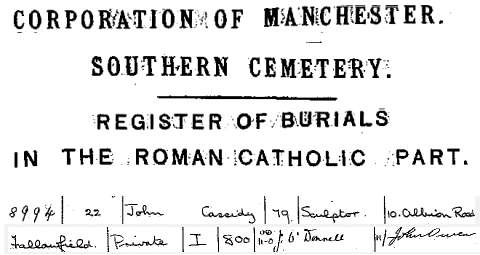
The above extract (reformatted) is from the Cemetery's register. Cassidy's was the only burial on 22 July. The page of the book has 20 entries covering 7 - 27 July, six of which are recorded as 'Infant' - perhaps telling us something about the living conditions in the city even at that date. At 79, Cassidy was the oldest of the 20 people on the page.
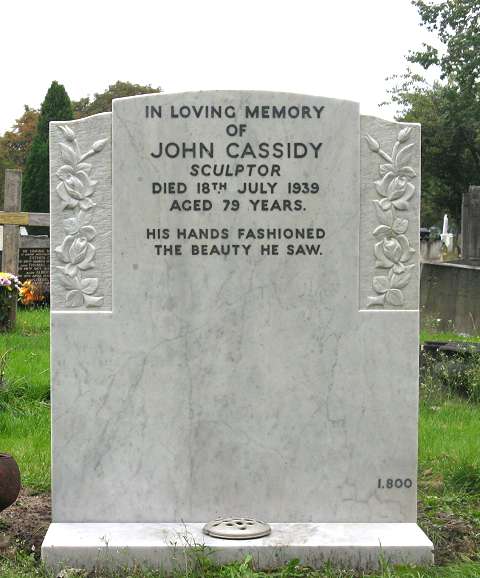
His gravestone carries the epitaph 'His hands fashioned the beauty he saw.' The marble gravestone,which had become very stained, was fully refurbished in 2010 to commemorate the 150th anniversary of his birth. Thanks are due to the members of the Slane Historical Society who funded this work.

The above plan shows the location of the grave, which is in Roman Catholic Section I; highlighted in blue and marked J.C. Another artist, L.S. Lowry, is also buried in Southern Cemetery (section C, marked L.L. above.) For location and opening hours, see the Cemetery's website. Walking (or driving - cars can reach the roadways shown) from the main entrance along the roadway between I and S, stop at the next-to-last tree: look across to your left and you will see the grave.
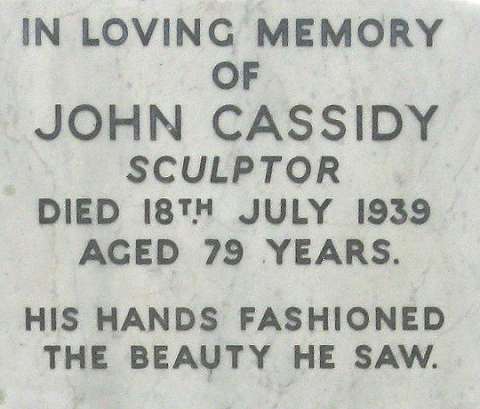
The inscription: it gives the date as 18th July, not 19th - perhaps explained by the report in the newspaper story that he died a few minutes after midnight.
For more about out visit to the Cemetery, see the News Page.
After the funeral, the relatives no doubt settled his remaining affairs, organised the removal of any possessions from his bachelor lodgings at 10 Albion Road, Fallowfield, and returned to Ireland, leaving us with little record of his life in Manchester except a few press cuttings, and of course his many sculptures and other works.
Cassidy's last work
A mystery surrounds the bust of Pope Pius XII on which he was working in the hospital. At some time the 1960s, his niece, Loretta Cassidy, visited Ireland and Manchester in search of traces of her uncle, and informed the press that she was interested in any stories about him. She received a letter, dated June 1969, from the secretary of a Mr. Peter Conlon of Manchester. It reads, in part:
Mr. Conlon
read in the Manchester
Evening News of your interest in sculptures done
by your uncle John Cassidy and wondered if you were
interested in seeing the last piece your uncle worked on
before he died in St. Joseph's hospital.
The piece is of Pope Pius XII and was for Mother Gabriel but was never finished completely and was taken by the students of your uncle and finished off after he died.
The letter is signed by Mrs. G.E. Steventon (Secretary).
The piece is of Pope Pius XII and was for Mother Gabriel but was never finished completely and was taken by the students of your uncle and finished off after he died.
The letter is signed by Mrs. G.E. Steventon (Secretary).
Unfortunately Loretta Cassidy had left Manchester by then and does not appear to have followed up this lead. Peter Conlon was a builder: 1960 trade directories list Peter Conlon Ltd, 580 Stretford Road, Trafford Park, Building Contractor. He lived at 84 Seymour Grove, the address he gave to Loretta Cassidy, until 1978, but the we have not been able to trace the whereabouts of the bust after that. We'd very much like to have details of its history, and a picture. If you can help in any way, please do get in touch at the email address shown on the left.
Page created by Charlie Hulme, July 2009. Last update January 2025.